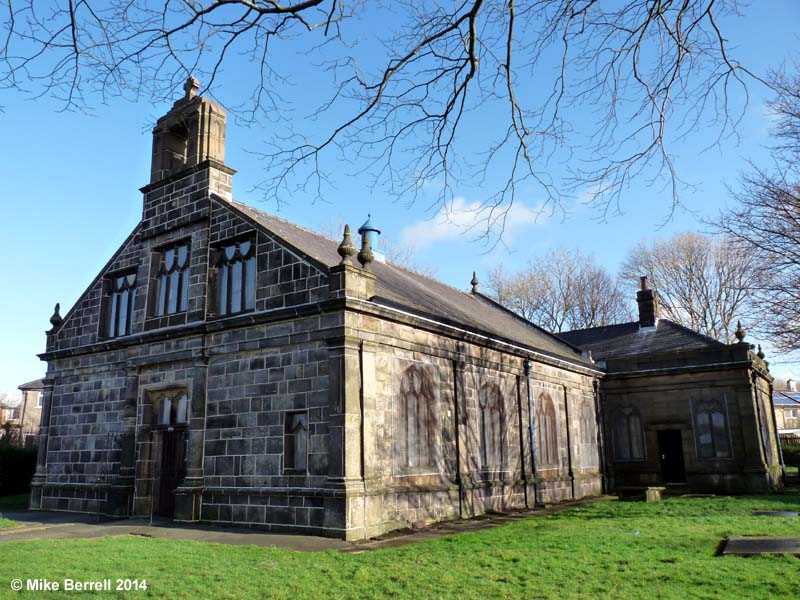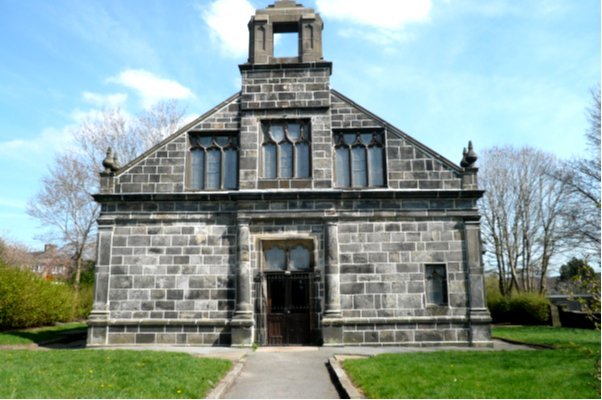 |
The Church of St James, Darwen |
 |

St James, Darwen

Abram, in his History of Blackburn Town and Parish (1877) wrote “No chapel existed in Over Darwen before the Reformation in the middle of the 16th Century. The date of this foundation cannot be fixed; but it was probably in the first years of Elizabeth’s reign that the inhabitants built a small fabric for a chapel-of-ease to Blackburn Parish Church. Harrison the itinerant names the chapel in 1577 in his reference to the course of the Darwen river” referring to it as Darwent Chappell. However, research has uncovered a document held in Chester Record Office stating that in the 26th year of the reign of Henry VIII (1535) the “Valuation in the King’s Book and Subsidies at 4p in the pound as they now pay to the King” refers to Blackburn Parish Church’s contribution to the tenthe (tithe) along with Tockholes, Harwood, Low, Long, Salmesbury and Darwin. This would suggest that a church in Darwen existed well before 1577.
In the early years the church was a Chapel of Ease. It was served by a curate from the mother church (Blackburn) paid for out of the interest on endowments to the church given for that purpose. There was no resident minister until 1647 when Mr. Joshua Bernard (sometimes referred to as Joshua Barnet) was appointed by the Presbytery to be minister at Over Darwen.
During the next 40 years nonconformity took a strong hold in the area and the church was used by both factions. However, a dispute as to the possession of the old chapel arose in 1687 between the Vicar of Blackburn and the Nonconformists. On petition to the King the dissenters obtained possession, but shortly afterwards a further petition to the King gave possession back to the Vicar of Blackburn. Much argument followed as the nonconformists claimed that the Chapel had probably been built by the inhabitants themselves and not by any ecclesiastical authority, and that it had never been consecrated by any Bishop. Also, the fact that the chapel had been allowed to fall into a ruinous state, and that the Vicar of Blackburn only sent a curate to perform a service once per month led them to believe they had a right to use the building. In their petition to the King the dissenters even offered to repair the building, but no reply appears to have been received and since then the Church of England has had undisputed possession of the old Darwen Chapel and the fabric that has succeeded it.
The Nonconformists moved out and provided themselves with a place of worship, firstly in a nearby barn. In the following year 1688, adherents of the Church of England took over the task of repairing the chapel and providing a stipend for a resident curate. They failed to do so and four years later the Vicar of Blackburn enforced a compulsory church rate to pay for this work.
Some thirty years later the old Darwen Chapel was demolished and the new Church of St James was built about 1722/3. It was also known as Higher Chapel because it stood on higher ground than its newly built neighbour, Lower Chapel. This church stood almost on the identical site of the old chapel, its foundations having been laid three or four feet to the north of the old ones. Writing in 1889, J. G. Shaw states that “the church is a simple parallelogram and it is said that the present St. James’s Church is exactly the same size as the old Darwen Chapel observed by Harrison in 1577”.
For a long time interments took place inside the old chapel and the church was completely undermined with vaults, long since closed for burial purposes, hence the reason for the new foundations being built a few feet to the north of the old foundations. Tradition says that the Churchmen rebuilt it in emulation of the Nonconformists who by this time had erected Lower Chapel in 1719.
In 1851, after standing unaltered for almost 130 years, St James’s was found to be in a dilapidated condition and deemed unsafe. Coal mining operations under the building had caused the land to sink and extensive cracks to both the building and the churchyard had appeared. For two years services were held in Holden Fold School whilst substantial work was carried out to restore the building and prop up the workings beneath. The walls were made sound, a new roof was put on, the north and south galleries were added and the organ in the old west gallery was enlarged. The interior was re-pewed and the pulpit and reading desk were altered. It is 58 feet by 40 feet with a semi-circular apse of 9 feet radius at the east end. It is built of stone and oak. There is no tower or spire, but a small cupola or bell turret surmounts the gable at the west end. A faculty was obtained during the restoration of 1851 for the construction of a cellar to house the new heating apparatus. Many coffins had to be removed and were found to be in an excellent state of preservation owing to the strong clay. Much difficulty was experienced in removing them and many had to be forced out and broken with pickaxes. In one corner of the churchyard there existed a charnel house and here the bones from this cellar were deposited. The number of interments in the churchyard was so great that for many years old graves were constantly being disturbed in digging new ones and the disturbed bones were invariably removed to the charnel house. An Order in Council was eventually obtained for the enlargement of the burial ground and the charnel house was abolished. Burials no longer take place in the graveyard.
The interior of the building has now been modernised and the pews replaced with chairs. A new kitchen has also been added.
| Darwen Home & Contents | ©Lancashire OnLine Parish Clerks | Lancashire Home |